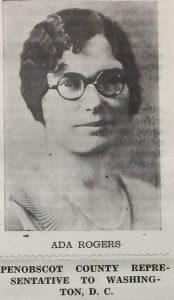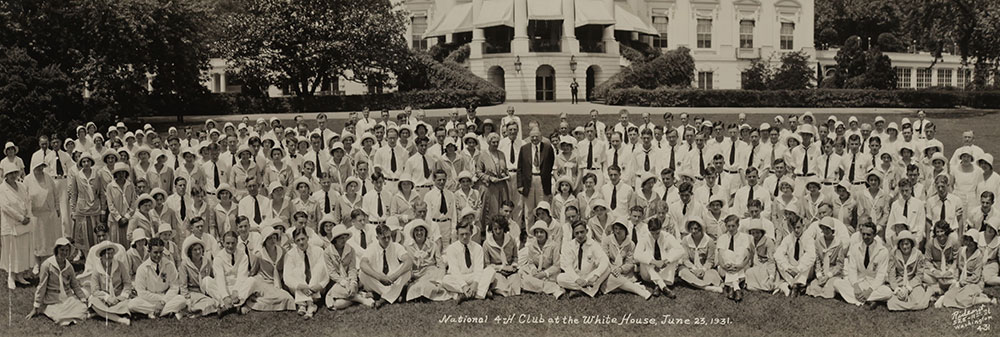National 4-H Camp/Conference and Andrew Watson
The National 4-H Camp materials included in our collection were collected by Maine 4-H Member and four time Poultry Champion Andrew Watson during his participation in the 5th National Farm Boys’ and Girls’ 4-H Club Camp held in Washington, D.C. June 17-23, 1931. Although the program content and purpose changed very little since the first camp was held in 1927, the name has been altered a number of times through the years finally settling on National 4-H Conference in 1957.
Regardless of the exact wording of the event’s name, National 4-H Conference is, and always has been, the ultimate award trip one can earn as a 4-H Member. This conference is called annually by the USDA Secretary of Agriculture as a means to gain insights into, and national direction for, the 4-H Program direct from the 4-H Members themselves. State 4-H Programs usually have a fairly rigorous selection process, usually including an interview by a panel of judges and a review of the member’s 4-H project work and involvement, to help them select their delegation members.

Always held in or near Washington, D.C., for the first 15 years delegations camped in tents on the mall. Watson wrote the camp was “located where it is overlooked by (the) Washington Monument.”
World War II forced events such as this to be placed on hold 1942-1945 but in 1946 the Camp/Conference was re-started. After WWII, however, delegations no longer stayed in tents on the mall. Road and bridge expansion after the war eliminated the campsites, so the conference was held at various locations in and around the D.C. area each year until 1959 when the event settled in the new National 4‑H Center in Chevy Chase, Maryland; built partly to house this event!
The event, itself, generally hasn’t changed since its inception. Assemblies with inspirational speakers in the mornings; recreational/social experiences like dances, movies or “Drama Night” in the evenings; and educational/informational tours in and around Washington and current-topic discussion group sessions in which the 4‑H’ers are asked to state their needs and opinions about their 4-H experiences, fill out the days.
Watson was one of four Maine 4-H’ers selected in 1931 to attend the National 4-H Club Camp. Joining Andrew as members of the Maine Delegation were Mary B. Bryant, Androscoggin County; Otis Proctor, York County; and Ada Rogers, Penobscot County. Bryant joined 4-H in 1925 and chose canning as her first project. During her 4-H years she also enrolled in sewing, cooking, and room improvement. Proctor joined in 1927 focusing on potatoes and poultry. Rogers joined in 1924 as a 4-H Canning project member until 1930 when she switched to sewing.
 Ada Rogers had graduated with first honors from Bangor High School in 1930 and was attending Farmington Normal School studying Home Economics when she was selected to attend the National 4-H Camp in 1931. During her week in Washington she not only had a small item of hers included in the Camp newsletter, 4-H Forage, but was asked to provide a radio presentation as well.
Ada Rogers had graduated with first honors from Bangor High School in 1930 and was attending Farmington Normal School studying Home Economics when she was selected to attend the National 4-H Camp in 1931. During her week in Washington she not only had a small item of hers included in the Camp newsletter, 4-H Forage, but was asked to provide a radio presentation as well.
The 4-H Forage, edited by camp staff, was a daily summary of the camp’s activities written mostly by camp delegates. Ada’s contribution appeared in the last day’s issue (v5, #5, p5) and described the attendance by “a large representation of the delegates” of Sunday morning services held at Christ Church in Alexandria, VA; the same church once attended by George Washington. “Some of us even sat in the same pew which Washington used.” She noted.
During the week the camp provided daily radio broadcasts. Ada’s contribution discussed the experience of “meeting 4‑H Club boys and girls from the four corners of the United States.” She had to miss the tour of the Smithsonian National Museum of Natural History to tell the world that “since I am from the Northeast corner of the United States, I especially wanted to meet boys and girls from the other three corners.” Her presentation went on to describe meeting the delegation from Florida; the delegates from New Mexico and Neca Jones “…from far Nevada”; and the delegates from Washington State. “If I had the time,” she added, “I could tell you of the many friendships that I have made throughout the United States. This trip and the many friendships that we make are memories that will always last.” Of the experience of giving a radio broadcast, she wrote in the Club Echoes newsletter, “It was the first time that I had ever spoken over the radio but I must say that it is nothing of which to be afraid.”
The four delegates kept notes of their daily experiences so they could write about their experiences in the Club Echoes newsletter after their return. Otis mentioned the “new experience of sleeping on the train” in the Club Echoes stating, “We took the Pullman to Washington”. Andrew’s notes describe tours of famous sites such as the Washington Monument (“Here we got our first real view of a wonderful panorama with the whole of Washington spreading out at our feet”); Mount Vernon (“Here we placed a wreath on the tomb of Washington then proceeded to look over the grounds. The house is kept in the condition as near as possible as it was in the original condition”), and Mount St. Albans Cathedral which is known today as Washington National Cathedral (an “all stone building” where he saw “wonderful sculputring (sic)”). Apparently, according to Andrew’s notes, the delegation was “happily surprised at noon by being invited out to lunch by Congressman Beedy who gave (us) a most enjoyable hour with marvelous eats.”
Ada’s Club Echoes paragraph mentions her new friend Neca Jones, and her fellow delegate, Andrew, placing a wreath on the Tomb of the Unknown Soldier while visiting Arlington National Cemetery. Both Ada and Mary mention seeing President Hoover and shaking hands with Mrs. Hoover during their visit to the White House. Ada found seeing the president and shaking Mrs. Hoover’s hand to be “the most outstanding things that I remember from my trip to the 4-H Club Camp.” Mary says that after visiting with the Hoovers “we went out by the South entrance where we waited on the lawn” for the Hoover’s to join them for a group photograph.
Remarks about the daily assemblies were many including Andrew hearing “many ideas in connection with Social Relations and family life” during the Thursday assembly and during the Saturday assembly “Lieut. Commander C. E. Rosendahl, U. S. Navy, gave a very interesting address on aviation which was enjoyed by all.”
Scattered throughout the notes are comments such as “write home”, “got to be in play Friday night – schoolboy” (a comment supported by Andrew’s name being included for such in the 4-H Forage), and “the climax of the evening was a waltz then back to camp we went tired but happy.” Mary mentions that “A candlelight service about the campfire closed 1931 Camp” and that they stopped in New York on the trip home for performances by Concert Organist Jesse Crawford and Rudy Vallee and his Connecticut Yankees. She ends saying, “We were very glad to get back to Maine and felt that we had had a most worthwhile trip.”
More information about the National 4-H Conference can be found on the National 4-H History Preservation Website, 4-H National Headquarters, NIFA, USDA website, and the National 4-H Conference website.

